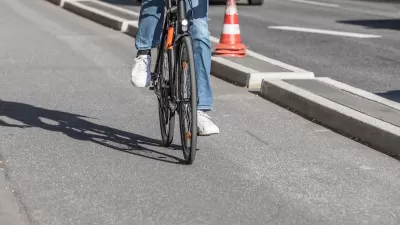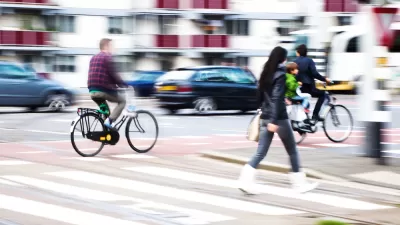The New York Times goes over the debate over whether it is acceptable to let children walk to school nowadays. The topic has many parents expressing mixed feelings about the issue.
As The New York Times reports about a young girl who is the only student who walks a block and a half to her school, many issues have come up in the debate. Is the world indeed less safe? How has design and suburban sprawl influenced where kids can walk to?
When to detach the parental leash? The trip to and from school has become emblematic of the conflict parents feel between teaching children autonomy and keeping them safe. In parenting blogs and books, the school-bus stop itself is shorthand for the turmoil of contemporary parents over when to relinquish control.
In 1969, 41 percent of children either walked or biked to school; by 2001, only 13 percent still did, according to data from the National Household Travel Survey. In many low-income neighborhoods, children have no choice but to walk. During the same period, children either being driven or driving themselves to school rose to 55 percent from 20 percent. Experts say the transition has not only contributed to the rise in pollution, traffic congestion and childhood obesity, but has also hampered children's ability to navigate the world.
FULL STORY: Why Can’t She Walk to School?

Alabama: Trump Terminates Settlements for Black Communities Harmed By Raw Sewage
Trump deemed the landmark civil rights agreement “illegal DEI and environmental justice policy.”

Planetizen Federal Action Tracker
A weekly monitor of how Trump’s orders and actions are impacting planners and planning in America.

The 120 Year Old Tiny Home Villages That Sheltered San Francisco’s Earthquake Refugees
More than a century ago, San Francisco mobilized to house thousands of residents displaced by the 1906 earthquake. Could their strategy offer a model for the present?

In Both Crashes and Crime, Public Transportation is Far Safer than Driving
Contrary to popular assumptions, public transportation has far lower crash and crime rates than automobile travel. For safer communities, improve and encourage transit travel.

Report: Zoning Reforms Should Complement Nashville’s Ambitious Transit Plan
Without reform, restrictive zoning codes will limit the impact of the city’s planned transit expansion and could exclude some of the residents who depend on transit the most.

Judge Orders Release of Frozen IRA, IIJA Funding
The decision is a victory for environmental groups who charged that freezing funds for critical infrastructure and disaster response programs caused “real and irreparable harm” to communities.
Urban Design for Planners 1: Software Tools
This six-course series explores essential urban design concepts using open source software and equips planners with the tools they need to participate fully in the urban design process.
Planning for Universal Design
Learn the tools for implementing Universal Design in planning regulations.
Clanton & Associates, Inc.
Jessamine County Fiscal Court
Institute for Housing and Urban Development Studies (IHS)
City of Grandview
Harvard GSD Executive Education
Toledo-Lucas County Plan Commissions
Salt Lake City
NYU Wagner Graduate School of Public Service





























